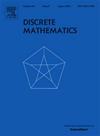一个精致的观点,一个奇怪的身份划分为奇数部分与指定的求和
IF 0.7
3区 数学
Q2 MATHEMATICS
引用次数: 0
摘要
2002年,Andrews, Lewis和Lovejoy引入了组合对象,他们称之为带有指定求和的分区。它们是通过采用不受限制的整数分区来构造的,并精确地指定一个部分每次出现的一次。在同一工作中,他们还考虑了指定求和项且所有部分都必须为奇数的受限分区,用PDO(n)表示对应的函数。PDO(n)满足的最奇特的恒等式之一是:对于所有n≥0,PDO(2n)=∑k=0nPDO(k)PDO(n−k)。从生成函数的角度来看,这相当于证明∑n≥0PDO(2n)qn=(∑n≥0PDO(n)qn)2。上面的结果很容易通过基本的生成函数操作来证明。在这项工作中,我们的目标是通过提供上述生成函数恒等式的双参数泛化来扩展上述结果。我们通过考虑各种自然分割统计,然后利用安德鲁斯和罗斯2013年论文中出现的思想来做到这一点,这些思想可以追溯到一个世纪前P. a .麦克马洪关于除数和的自然推广的开创性工作。本文章由计算机程序翻译,如有差异,请以英文原文为准。
A refined view of a curious identity for partitions into odd parts with designated summands
In 2002, Andrews, Lewis, and Lovejoy introduced the combinatorial objects which they called partitions with designated summands. These are constructed by taking unrestricted integer partitions and designating exactly one of each occurrence of a part. In the same work, they also considered the restricted partitions with designated summands wherein all parts must be odd, and they denoted the corresponding function by .
One of the most curious identities satisfied by is the following: For all , From a generating function perspective, this is equivalent to proving that The above results are easily proven via elementary generating function manipulations.
In this work, our goal is to extend the above results by providing a two–parameter generalization of the above generating function identity. We do so by considering various natural partition statistics and then utilizing ideas that appear in a 2013 paper of Andrews and Rose which date back a century to groundbreaking work of P. A. MacMahon on natural generalizations of divisors sums.
求助全文
通过发布文献求助,成功后即可免费获取论文全文。
去求助
来源期刊

Discrete Mathematics
数学-数学
CiteScore
1.50
自引率
12.50%
发文量
424
审稿时长
6 months
期刊介绍:
Discrete Mathematics provides a common forum for significant research in many areas of discrete mathematics and combinatorics. Among the fields covered by Discrete Mathematics are graph and hypergraph theory, enumeration, coding theory, block designs, the combinatorics of partially ordered sets, extremal set theory, matroid theory, algebraic combinatorics, discrete geometry, matrices, and discrete probability theory.
Items in the journal include research articles (Contributions or Notes, depending on length) and survey/expository articles (Perspectives). Efforts are made to process the submission of Notes (short articles) quickly. The Perspectives section features expository articles accessible to a broad audience that cast new light or present unifying points of view on well-known or insufficiently-known topics.
 求助内容:
求助内容: 应助结果提醒方式:
应助结果提醒方式:


